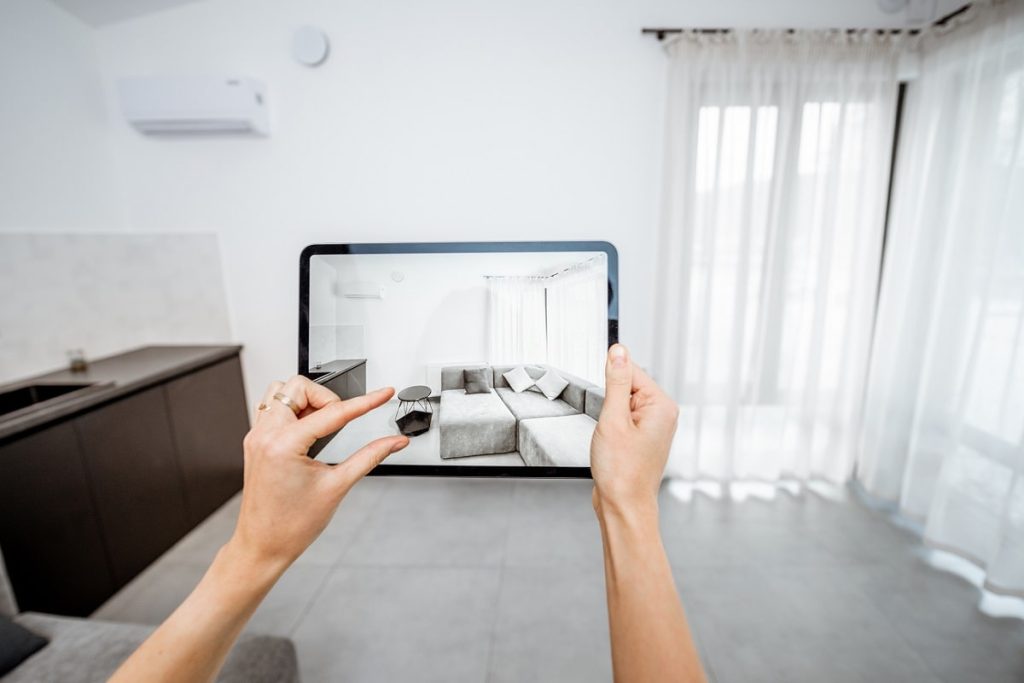
In the dynamic landscape of technology, Augmented Reality (AR) and Virtual Reality (VR) have emerged as transformative tools reshaping businesses’ connections with their customers.
These immersive technologies have transcended their initial gaming and entertainment roles to establish a strong presence in diverse industries like retail, real estate, healthcare, and education.
This article explores the profound impact of AR and VR on customer experiences, delving into how they are revolutionizing engagement and fostering stronger bonds between brands and their audience.
Understanding Augmented Reality (AR) and Virtual Reality (VR)
Augmented Reality (AR): Blending Digital Enhancements with Reality
AR enriches the real world by overlaying digital elements onto physical environments. In contrast to the immersive isolation of VR, AR enhances the user’s reality perception by integrating virtual content. This is often experienced through smartphones, tablets, and specialized AR glasses, offering users contextual and interactive information.
Virtual Reality (VR): Immersion in Digital Realms
VR transports users to entirely digital environments, effectively disconnecting them from the physical world. Through VR headsets, users step into a simulated reality where they can interact with objects and surroundings akin to real-world experiences.

Revolutionizing Customer Engagement Across Industries
Bridging Reality and Digital Enhancements with Augmented Reality (AR)
AR serves as a potent bridge between the tangible and the digital, enriching reality by overlaying virtual elements onto the physical world.
Consider using your smartphone to visualize how a new piece of furniture fits seamlessly into your living room. AR applications empower users to explore products from various angles, experiment with colors, and make informed decisions before making a purchase.
Enhancing Product Visualization
Addressing the challenge of limited physical interaction with online products, AR and VR technologies offer innovative solutions.
AR: Augmented Reality empowers customers to visualize products in their surroundings. Fashion retailers use AR apps that enable customers to virtually try on clothing and accessories, helping them assess fit and style without physical trial rooms.
VR: In the automotive industry, VR revolutionizes the test-drive process. Potential buyers can experience test drives without geographical barriers, gaining comprehensive insights into vehicle features.
Creating Immersive Shopping Experiences
AR and VR redefine shopping, merging digital and physical worlds for unique experiences.
AR: Retailers leverage AR for in-store shopping. By scanning products with AR-capable devices, customers access additional information, reviews, and virtual try-ons, bridging e-commerce convenience and in-store engagement.
VR: Luxury brands utilize VR to reimagine retail. With VR headsets, customers enter meticulously designed digital flagship stores, exploring products and interacting with virtual staff from home.
Virtual Try-Before-You-Buy Experiences
AR and VR redefine trying before buying, offering risk-free evaluation opportunities.
AR: The beauty industry undergoes transformation with AR-powered virtual makeup try-ons. Customers experiment with makeup virtually, visualizing shades and styles before purchasing.
VR: Real estate experiences a virtual revolution. VR-enabled property tours allow remote navigation through homes, widening the market reach.
Interactive Brand Storytelling
AR and VR enable interactive brand storytelling, fostering deeper customer connections.
AR: Beverage companies use AR for captivating narratives. Scanning product labels unlocks engaging multimedia content, sharing brand heritage and sustainability initiatives.
VR: In travel, VR inspires wanderlust through virtual destination experiences. Customers explore exotic locations, forming emotional bonds with travel destinations.
Education and Training
AR and VR transform education and training.
AR: Healthcare uses AR for patient education, explaining medical procedures visually.
VR: Businesses use VR for customer training. Automobile manufacturers provide virtual driving lessons and maintenance tutorials, imparting essential skills.
AR and VR Applications
AR in Retail: Virtual Dressing Room
AR significantly impacts retail. Cosmetic brands use AR apps for virtual makeup trials. Clothing shoppers visualize outfits without changing clothes, boosting customer confidence.
AR in Navigation: Innovative Way to Navigate
AR-augmented navigation redefines travel. Digital arrows superimposed on the real world simplify directions, enhancing travel experiences.
AR in Education: Interactive Learning
AR enriches education. Biology students explore 3D cell models, history enthusiasts witness historical events through virtual reenactments, and geography learners embark on virtual landmark tours.
VR: Immersive Adventures Beyond Reality
VR immerses users in virtual environments, transcending the physical world.
VR in Tourism: Virtual Exploration
VR revolutionizes travel by offering virtual tours of destinations, fueling wanderlust and aiding trip planning.
VR in Training and Simulation: Learning through Immersion
Industries like healthcare and aviation use VR for immersive training. Surgeons practice procedures, pilots undergo flight training, and engineers troubleshoot virtually.
VR in Therapy: Healing in Virtual Environments
VR serves as a therapeutic tool for pain management and relaxation in healthcare, providing serene virtual settings.
Benefits of AR and VR Integration
The integration of Augmented Reality (AR) and Virtual Reality (VR) into business strategies offers a plethora of benefits that collectively enhance customer experiences and drive innovation. These technologies go beyond entertainment and gaming, transforming industries by delivering immersive and interactive solutions. Let’s explore the key advantages of incorporating AR and VR into your business framework:
Personalization and Engagement: AR and VR open avenues for personalized experiences that cater to individual preferences. By tailoring content, products, and interactions based on user data, businesses can capture customer attention and foster deeper engagement. Personalized experiences resonate more effectively, enhancing brand loyalty and customer satisfaction.
Improved Product Visualization: Industries such as real estate, e-commerce, and manufacturing benefit immensely from AR and VR. These technologies enable customers to visualize products, spaces, and prototypes in detail. Potential buyers can interact with virtual versions of products, gaining a clearer understanding of features, functions, and dimensions. This reduces uncertainties and minimizes the likelihood of post-purchase dissatisfaction.
Interactive Marketing Campaigns: AR and VR provide innovative platforms for interactive marketing campaigns. By leveraging these technologies, brands can create immersive experiences that generate curiosity and excitement among customers. Interactive elements like AR-powered advertisements, virtual tours, and engaging games not only increase brand visibility but also enhance customer engagement, fostering a stronger connection between the brand and its audience.
Empathy and Emotional Connection: Virtual Reality’s immersive nature allows businesses to evoke emotions and establish profound connections with their audience. VR experiences can transport users to emotionally resonant settings, triggering empathetic responses and generating lasting memories. This emotional bond cultivates brand loyalty, advocacy, and a sense of community among customers.

Enhanced Learning and Training: AR and VR revolutionize education and training programs by offering dynamic and immersive learning experiences. In industries that require practical skills, like healthcare, manufacturing, and aviation, these technologies provide realistic simulations of complex scenarios. This accelerates skill acquisition, reduces training costs, and enhances knowledge retention, resulting in a more competent workforce.
Efficient Problem Solving and Decision Making: AR and VR technologies empower businesses to streamline problem-solving processes and aid in decision-making. For instance, virtual simulations can help engineers identify flaws in prototypes, medical professionals can practice surgeries in risk-free environments, and architects can visualize building designs at scale. This accelerates innovation and minimizes errors, contributing to improved efficiency and effectiveness.
Enhanced Customer Support: AR and VR can enhance customer support by offering virtual assistance and troubleshooting. Through AR-enabled apps, customers can receive step-by-step guidance for assembling products, fixing technical issues, or conducting repairs. This reduces the need for extensive customer support calls and increases user satisfaction.
Reduced Physical Barriers: VR technologies can transcend geographical barriers and physical limitations. For instance, customers can virtually visit real estate properties, attend events, or experience tourist destinations from the comfort of their homes. This accessibility increases customer reach and engagement, tapping into a global audience.
Innovative Product Development: AR and VR enable businesses to experiment with innovative product concepts before investing in physical prototypes. This accelerates the product development cycle, reduces costs, and allows for rapid iterations based on user feedback. Businesses can test designs, features, and functionalities virtually, ensuring that the final product aligns with customer expectations.
Future-Proofing Business Models: Integrating AR and VR showcases a business’s commitment to innovation and staying ahead of industry trends. As these technologies continue to evolve, businesses that have already adopted AR and VR will be well-prepared to adapt to future advancements. This future-proofing ensures that the business remains competitive and can quickly embrace emerging opportunities.
Pioneering an Enriched Reality
AR and VR’s influence extends beyond customer experiences, reshaping industries and interactions with the world. Embracing these technologies pioneers innovation and engagement, promising exciting prospects.
In conclusion, AR and VR redefine customer engagement, propelling it to new heights. These technologies forge enduring relationships and offer boundless opportunities for interaction, innovation, and imagination.

Started working as a digital marketing expert, Varun Sharma is now also a well-known digital marketing speaker – a speaker on performance development, and a trusted mentor to businesses in the digital world. His keynote expositions are based on the digital marketing theories, which provide a fascinating insight into the secrets of high performance.

